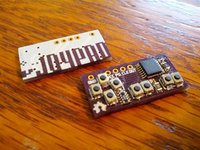skeezix
Internal Development
Quite alright, since we don't have a hardware hacking forum so to speak 
I can't be posting every day.. i) this stuff takes time, and ii) I don't get a lot, and iii) my time is at midnight-3am, and with the amount of sleep I get, I have to think slow and hard or I bollox it all up..
.. so by all means, chat here (or make another thread), just to keep it interesting
right now I'm trying to work out the memory switcher using A/B multiplexers. I'm sure its not very hard, but my brain is slow tonight, and diagramming tools again all suck donkey balls. (Visio is okay, but is of course commercial; Dia is okay, but instead I fiddled with Kivio (now Calligra Flow) which turns out it can't save-as or export to anything other than its own format or odg ... and when you open the odg in LibreOffice, its all screwed up! Great, thanks for the waste of time guys!) .. I should just've used Dia or Inkscape since they're proven.. or gone right to Eagle. Ah well.
Anyway, I'll post a minimal schematic maybe tomorrow or next day, that shows where i'm going with hardware double-buffering .. that'll make stuff pretty slick!
jeff
I can't be posting every day.. i) this stuff takes time, and ii) I don't get a lot, and iii) my time is at midnight-3am, and with the amount of sleep I get, I have to think slow and hard or I bollox it all up..
.. so by all means, chat here (or make another thread), just to keep it interesting
right now I'm trying to work out the memory switcher using A/B multiplexers. I'm sure its not very hard, but my brain is slow tonight, and diagramming tools again all suck donkey balls. (Visio is okay, but is of course commercial; Dia is okay, but instead I fiddled with Kivio (now Calligra Flow) which turns out it can't save-as or export to anything other than its own format or odg ... and when you open the odg in LibreOffice, its all screwed up! Great, thanks for the waste of time guys!) .. I should just've used Dia or Inkscape since they're proven.. or gone right to Eagle. Ah well.
Anyway, I'll post a minimal schematic maybe tomorrow or next day, that shows where i'm going with hardware double-buffering .. that'll make stuff pretty slick!
jeff





